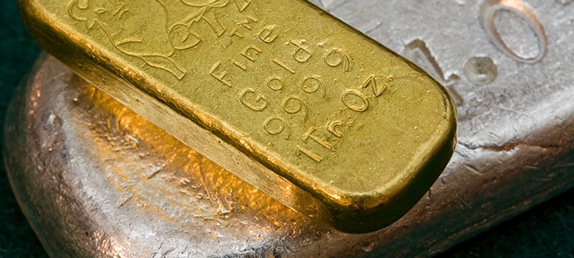
The gold silver ratio provides some interesting insights to the overall trends in precious metals markets.
Those who buy gold and silver have looked to a relationship between these and other precious metals and commodities throughout history. There is an underlying belief by many that there is a balancing ratio that, over the long-term, can help in evaluating current market prices.
Understanding the Gold Silver Ratio
In the simplest terms, the current market prices for an ounce of silver and an ounce of gold determine the market gold-to-silver ratio 1. For example, if an ounce of silver is selling for $30 and gold is priced at $1,200, the ratio is 40:1. Swings and trends in this ratio are one of the many indicators gold buyers and investors use to evaluate their market positions.
When evaluating the right time to buy or to sell any precious commodity, it is important to remember the goals of a trader and investor. Many day-to-day ratios and values have little value to the long-term holder. However, some ratios, such as the gold-to-silver evaluation, often tell a lot about longer-term trends and prices.
What Does the Gold Silver Ratio Mean for Trading?
Silver has always had a lower market value than gold due to its more abundant supply. It is estimated that there is 17 to 20 times more recoverable silver available than that of gold. That helps peg the general ratio of 17:1, although a number of other factors today play a role in setting the actual market prices of each metal. Moreover, gold is unique among speculative investments in that gold is considered non-consumable: Its value can be recovered even after being used in most applications.
Historical ranges are used by more experienced traders and gold investors to form their view on the current market. However, there is no single number that is seen as a trigger point or specific buy-sell signal. Generally speaking, the higher the ratio, the more the market is favoring the acquisition of silver. This is because a high ratio indicates a cheap price of silver.
Likewise, a low ratio is seen by many more sophisticated investors as the time to rebalance their portfolios towards gold and away from silver. Again, this is because they see the market pricing gold more cheaply than silver.
The Historical Role of the Gold Silver Ratio
Even ancient governments attempted to adjust their coinage with an agreed valuation between the perceived values of gold and silver. (Romans dictated a ratio of 12:1.) In more modern markets, the comparative prices have been driven by a number of factors. While the ratio floats today based on daily valuations, this has not always been the case. Since the 1600s some governments have sought monetary stability by fixing the ratio at the 16:1 to 19:1 range.
The earliest record keeping of these prices started in 1687, and the ratio between these two metals has swung widely between 14 and 100 since that time. Until the early 1900s, the gold silver ratio was fairly constant around 16:1 and 17:1. In fact, many bankers and traders of this period believed the universal ratio to be 17 during their lifetimes. By the mid-to-late 20th century, the ratio had moved to 45 to 50, with some extreme swings during unusual markets.
The Gold Silver Ratio as a Tool to Balance Your Portfolio
Today, there are two basic views of how to incorporate the gold silver ratio into a precious metals investment philosophy. The first is for the less experienced, long-term trader and investor. In this situation, one simply works with a trusted advisor like Scottsdale Bullion and Coin to develop a target ratio for both a high and a low point. When those points are reached, the investment portfolio is adjusted by either buying more silver if the ratio is high or acquiring more gold if the ratio is low. This scenario is adding to total portfolio holdings.
The second approach is to rebalance an existing portfolio based on the existing prices. For example, if the ratio hits 100 or higher, the gold investor would sell off an ounce of gold to purchase one hundred ounces of silver. The same strategy would apply if the ratio hit a low such as 40, but in this case selling 40 silver ounces to buy one ounce of gold when gold prices are attractive.
In short, the gold silver ratio is a helpful tool for those who wish to gain more insights into the markets for gold and silver.
Additional Sources:
1 – http://www.investopedia.com/terms/g/gold-silver-ratio.asp


